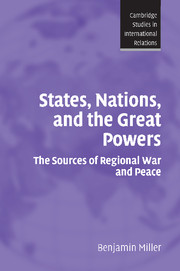Book contents
- Frontmatter
- Contents
- List of figures
- List of tables
- Preface and acknowledgments
- 1 Why some regions are peaceful and others are not
- 2 A theory of regional war and peace
- 3 States, nations, and war
- 4 Explaining the war proneness of the Middle East
- 5 The great powers war and peace in the Middle East
- 6 War and peace in the Balkans: states, nations, and great powers
- 7 The state-to-nation balance and the emergence of peace in South America during the twentieth century
- 8 The emergence of high-level peace in post-1945 Western Europe: nationalism, democracy, hegemony, and regional integration
- 9 Conclusions
- Appendix A Comparative dimensions of the state-to-nation imbalance in the Middle East, the Balkans, South America, and Western Europe in the post-1945 era
- Appendix B Data-file: major armed conflicts/wars by region, type, and modes of great power regional involvement (1945–2004)
- Bibliography
- Index
- Cambridge Studies in International Relations
2 - A theory of regional war and peace
Published online by Cambridge University Press: 22 September 2009
- Frontmatter
- Contents
- List of figures
- List of tables
- Preface and acknowledgments
- 1 Why some regions are peaceful and others are not
- 2 A theory of regional war and peace
- 3 States, nations, and war
- 4 Explaining the war proneness of the Middle East
- 5 The great powers war and peace in the Middle East
- 6 War and peace in the Balkans: states, nations, and great powers
- 7 The state-to-nation balance and the emergence of peace in South America during the twentieth century
- 8 The emergence of high-level peace in post-1945 Western Europe: nationalism, democracy, hegemony, and regional integration
- 9 Conclusions
- Appendix A Comparative dimensions of the state-to-nation imbalance in the Middle East, the Balkans, South America, and Western Europe in the post-1945 era
- Appendix B Data-file: major armed conflicts/wars by region, type, and modes of great power regional involvement (1945–2004)
- Bibliography
- Index
- Cambridge Studies in International Relations
Summary
In this chapter I present in greater detail my theory of regional war and peace. I specify the dependent and independent variables and the causal relations between them. The various elements of the theory are developed further in subsequent chapters. Following the introduction of the phenomenon to be explained — typology of regional war and peace outcomes — I draw on the discussion in chapter 1 to introduce three major theoretical perspectives at two levels of analysis. The three theoretical perspectives are realism, liberalism, and international society, and the two levels of analysis are the global and regional/domestic levels. Although the three theoretical perspectives are useful for deriving the variables and propositions of my theory, none is able, by itself, to explain the key variations of the phenomenon. I thus introduce my synthesis as a single coherent explanation of regional war and peace. In subsequent sections I show under what conditions the expectations of each of the theoretical perspectives will be met.
The phenomena to be explained
Defining a region
The two key elements that transform a certain group of states into a region are (1) a certain degree of geographical proximity and (2) strategic interaction (Schelling 1966) or security interdependence (Morgan 1997, pp. 25–26). Some geographical contiguity is a necessary element in defining a region. Still, it is the intense interactions and the extent of interdependence among a group of neighboring states, rather than mere geographical considerations, that determine a region's boundaries.
- Type
- Chapter
- Information
- States, Nations, and the Great PowersThe Sources of Regional War and Peace, pp. 41 - 81Publisher: Cambridge University PressPrint publication year: 2007

